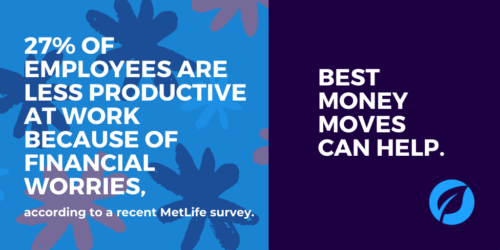2022 is right around the corner, and with it comes a new opportunity to update your benefits offerings to better serve your employees.
Here are five benefits trends we’ve identified as must-haves for 2022:
1. Financial wellness programs.
Finances consistently rank as a top stressor for employees, but many employers remain unaware of the impacts of long-term financial stress. The reality is, prolonged financial stress can result in anxiety, depression and burnout for employees and can even contribute to higher turnover and decreased productivity. In a recent MetLife survey, 27 percent of employees said they are less productive at work because of financial worries, an increase from 23 percent just six months prior.
Financial wellness programs, like Best Money Moves, can help employees regain control of their finances. Best Money Moves has tools and features that help employees measure their financial stress, budget for monthly expenses, pay down debt and plan for emergencies. Employees can talk to trained professional financial counselors and educate themselves about everything from investing to co-signing loans to buying their first homes with access to a library of over 700 articles, videos and calculators.
2. Accessible paid leave.
In 2021, the White House introduced the American Families Plan, which includes a comprehensive parental, medical and family leave program. Regardless of whether the plan is passed, however, it indicates a real shift in how Americans are thinking about leave — 75 percent of voters said they would support a national paid family and medical leave policy that covers all workers.
While many employers are catching up to this trend, there’s still a real discrepancy in how many workers want the benefit and how many actually have access to it. According to the same MetLife survey, 80 percent of employees were interested in paid leave, but only 57 percent of their employers offered any kind of leave, paid or otherwise.
3. Remote work flexibility.
The COVID-19 pandemic has undoubtedly changed the way we work, with many offices adapting to a hybrid strategy, a balance between working in person and working from home. For some, though, the option to work from home has become essential for various reasons, with nearly half of the employees in a recent PWC report responding that they would want to work remotely three days a week or more.
And the research shows that offering more flexibility doesn’t equate to a loss in productivity — a survey tracking more than 30,000 workers found that 6 in 10 reported being more productive working from home than they expected.
4. Mental health support.
Feelings of burnout and depression are on the rise, and employees are looking to their employers to help. According to MetLife, 37 percent of employees polled felt stressed while working more than half the time. Another 34 percent felt burned out while working more than half the time and 22 percent felt depressed while working more than half the time — all major increases from the previous year.
Burnout can lead to higher employee turnover, low productivity and increased absenteeism at work. Consider adding accessible mental health benefits to your health insurance plan and strive for an office culture that rewards employees who ask for help. These strategies can help combat this upward trend and help your workers both feel better and work better.
5. Help with student loan repayment.
Millennials, who make up the largest chunk of the current workforce, have more student loan debt than any other generation. As such, adding student loan repayment to your benefits packages can help you attract and retain employees.
Plus, there’s more of an incentive than ever to consider this benefit in 2022: last year, Congress passed the Consolidated Appropriations Act, allowing employers to make tax-free contributions of up to $5,250 a year to their employees’ student debt, without the payments being included in the employees’ taxable income. This was originally included in the pandemic-related CARES Act but has been granted an extension through the end of 2025 with many hoping the change will become permanent.
If you want to learn more about how Best Money Moves can bring financial wellness to your company, download our whitepapers.


